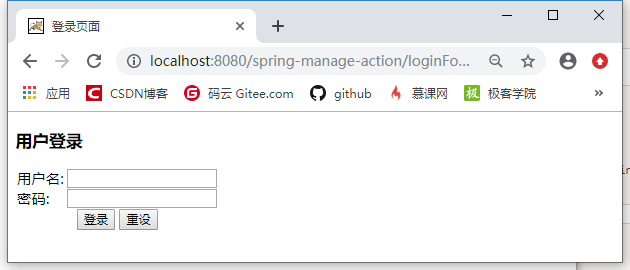Spring与Struts整合之使用自动装配操作示例
人气:0本文实例讲述了Spring与Struts整合之使用自动装配操作。分享给大家供大家参考,具体如下:
一 Web配置
<?xml version="1.0" encoding="GBK"?>
<web-app xmlns="http://xmlns.jcp.org/xml/ns/javaee"
xmlns:xsi="http://www.w3.org/2001/XMLSchema-instance"
xsi:schemaLocation="http://xmlns.jcp.org/xml/ns/javaee
http://xmlns.jcp.org/xml/ns/javaee/web-app_3_1.xsd" version="3.1">
<!-- 使用ContextLoaderListener初始化Spring容器 -->
<listener>
<listener-class>org.springframework.web.context.ContextLoaderListener
</listener-class>
</listener>
<!-- 定义Struts 2的FilterDispathcer的Filter -->
<filter>
<filter-name>struts2</filter-name>
<filter-class>org.apache.struts2.dispatcher.ng.filter.StrutsPrepareAndExecuteFilter</filter-class>
</filter>
<!-- FilterDispatcher用来初始化Struts 2并且处理所有的WEB请求。 -->
<filter-mapping>
<filter-name>struts2</filter-name>
<url-pattern>/*</url-pattern>
</filter-mapping>
</web-app>
二 applicationContext.xml配置
<?xml version="1.0" encoding="GBK"?>
<beans xmlns:xsi="http://www.w3.org/2001/XMLSchema-instance"
xmlns="http://www.springframework.org/schema/beans"
xsi:schemaLocation="http://www.springframework.org/schema/beans
http://www.springframework.org/schema/beans/spring-beans-4.0.xsd">
<!-- 定义一个业务逻辑组件,实现类为MyServiceImp,
此处的id必须与Action的setter方法名对应 -->
<bean id="ms"
class="org.crazyit.app.service.impl.MyServiceImpl"/>
</beans>
三 视图
1 loginForm.jsp
<%@ page contentType="text/html; charset=GBK" language="java" errorPage="" %>
<%@taglib prefix="s" uri="/struts-tags"%>
<!DOCTYPE html PUBLIC "-//W3C//DTD XHTML 1.0 Transitional//EN"
"http://www.w3.org/TR/xhtml1/DTD/xhtml1-transitional.dtd">
<html xmlns="http://www.w3.org/1999/xhtml">
<head>
<title>登录页面</title>
</head>
<body>
<h3>用户登录</h3>
<s:form action="login">
<s:textfield name="username" label="用户名"/>
<s:textfield name="password" label="密码"/>
<tr align="center">
<td colspan="2">
<s:submit value="登录" theme="simple"/>
<s:reset value="重设" theme="simple"/>
</td>
</tr>
</s:form>
</body>
</html>
2 welcome.jsp
<%@ page contentType="text/html; charset=GBK" language="java" errorPage="" %> <%@taglib prefix="s" uri="/struts-tags"%> <!DOCTYPE html PUBLIC "-//W3C//DTD XHTML 1.0 Transitional//EN" "http://www.w3.org/TR/xhtml1/DTD/xhtml1-transitional.dtd"> <html xmlns="http://www.w3.org/1999/xhtml"> <head> <title>成功页面</title> </head> <body> 您已经登录!<br/> <s:actionmessage /> </body> </html>
3 error.jsp
<%@ page contentType="text/html; charset=GBK" language="java" errorPage="" %> <!DOCTYPE html PUBLIC "-//W3C//DTD XHTML 1.0 Transitional//EN" "http://www.w3.org/TR/xhtml1/DTD/xhtml1-transitional.dtd"> <html xmlns="http://www.w3.org/1999/xhtml"> <head> <title>错误页面</title> </head> <body> 您不能登录! </body> </html>
四 Struts配置
<?xml version="1.0" encoding="GBK"?>
<!-- 指定Struts 2配置文件的DTD信息 -->
<!DOCTYPE struts PUBLIC
"-//Apache Software Foundation//DTD Struts Configuration 2.3//EN"
"http://struts.apache.org/dtds/struts-2.3.dtd">
<struts>
<!-- 配置了系列常量 -->
<constant name="struts.i18n.encoding" value="GBK"/>
<constant name="struts.devMode" value="true"/>
<constant name="struts.enable.DynamicMethodInvocation" value="false"/>
<package name="lee" extends="struts-default">
<!-- 定义处理用户请求的Action -->
<action name="login"
class="org.crazyit.app.action.LoginAction">
<!-- 为两个逻辑视图配置视图页面 -->
<result name="error">/WEB-INF/content/error.jsp</result>
<result>/WEB-INF/content/welcome.jsp</result>
</action>
<!-- 让用户直接访问该应用时列出所有视图页面 -->
<action name="*">
<result>/WEB-INF/content/{1}.jsp</result>
</action>
</package>
</struts>
五 action
package org.crazyit.app.action;
import com.opensymphony.xwork2.ActionSupport;
import org.crazyit.app.service.*;
public class LoginAction extends ActionSupport
{
// 下面是用于封装用户请求参数的两个成员变量
private String username;
private String password;
// 系统所用的业务逻辑组件
private MyService ms;
// 设值注入业务逻辑组件所必需的setter方法
public void setMs(MyService ms)
{
this.ms = ms;
}
// username的setter和getter方法
public void setUsername(String username)
{
this.username = username;
}
public String getUsername()
{
return this.username;
}
// password的setter和getter方法
public void setPassword(String password)
{
this.password = password;
}
public String getPassword()
{
return this.password;
}
// 处理用户请求的execute方法
public String execute() throws Exception
{
// 调用业务逻辑组件的validLogin()方法
// 验证用户输入的用户名和密码是否正确
if (ms.validLogin(getUsername(), getPassword()) > 0)
{
addActionMessage("哈哈,整合成功!");
return SUCCESS;
}
return ERROR;
}
}
六 Service
1 接口
package org.crazyit.app.service;
public interface MyService
{
int validLogin(String username , String pass);
}
2 实现类
package org.crazyit.app.service.impl;
import org.crazyit.app.service.*;
public class MyServiceImpl implements MyService
{
public int validLogin(String username , String pass)
{
// 此处只是简单示范,故直接判断用户名、密码是否符合要求
if ( username.equals("crazyit.org")
&& pass.equals("leegang") )
{
return 99;
}
return -1;
}
}
七 测试


希望本文所述对大家java程序设计有所帮助。
您可能感兴趣的文章:
加载全部内容